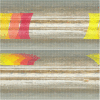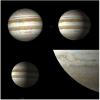Jupiter Science Enabled by ESA's Jupiter Icy Moons Explorer
- PMID: 37744214
- PMCID: PMC10511624
- DOI: 10.1007/s11214-023-00996-6
Jupiter Science Enabled by ESA's Jupiter Icy Moons Explorer
Abstract
ESA's Jupiter Icy Moons Explorer (JUICE) will provide a detailed investigation of the Jovian system in the 2030s, combining a suite of state-of-the-art instruments with an orbital tour tailored to maximise observing opportunities. We review the Jupiter science enabled by the JUICE mission, building on the legacy of discoveries from the Galileo, Cassini, and Juno missions, alongside ground- and space-based observatories. We focus on remote sensing of the climate, meteorology, and chemistry of the atmosphere and auroras from the cloud-forming weather layer, through the upper troposphere, into the stratosphere and ionosphere. The Jupiter orbital tour provides a wealth of opportunities for atmospheric and auroral science: global perspectives with its near-equatorial and inclined phases, sampling all phase angles from dayside to nightside, and investigating phenomena evolving on timescales from minutes to months. The remote sensing payload spans far-UV spectroscopy (50-210 nm), visible imaging (340-1080 nm), visible/near-infrared spectroscopy (0.49-5.56 μm), and sub-millimetre sounding (near 530-625 GHz and 1067-1275 GHz). This is coupled to radio, stellar, and solar occultation opportunities to explore the atmosphere at high vertical resolution; and radio and plasma wave measurements of electric discharges in the Jovian atmosphere and auroras. Cross-disciplinary scientific investigations enable JUICE to explore coupling processes in giant planet atmospheres, to show how the atmosphere is connected to (i) the deep circulation and composition of the hydrogen-dominated interior; and (ii) to the currents and charged particle environments of the external magnetosphere. JUICE will provide a comprehensive characterisation of the atmosphere and auroras of this archetypal giant planet.
Keywords: Atmospheres; Auroras; Chemistry; Dynamics; JUICE; Jupiter.
© The Author(s) 2023.
Conflict of interest statement
Competing InterestsThe authors declare that they have no competing financial or non-financial interests to declare that are relevant to the content of this article.
Figures


























References
-
- Achilleos N, Miller S, Tennyson J, Aylward AD, Mueller-Wodarg I, Rees D. JIM: a time-dependent, three-dimensional model of Jupiter’s thermosphere and ionosphere. J Geophys Res. 1998;103(E9):20089–20112. doi: 10.1029/98JE00947. - DOI
-
- Achterberg RK, Conrath BJ, Gierasch PJ. Cassini CIRS retrievals of ammonia in Jupiter’s upper troposphere. Icarus. 2006;182:169–180. doi: 10.1016/j.icarus.2005.12.020. - DOI
-
- Adriani A, Mura A, Moriconi ML, Dinelli BM, Fabiano F, Altieri F, Sindoni G, Bolton SJ, Connerney JEP, Atreya SK, Bagenal F, Gérard J-CMC, Filacchione G, Tosi F, Migliorini A, Grassi D, Piccioni G, Noschese R, Cicchetti A, Gladstone GR, Hansen C, Kurth WS, Levin SM, Mauk BH, McComas DJ, Olivieri A, Turrini D, Stefani S, Amoroso M. Preliminary JIRAM results from Juno polar observations: 2. Analysis of the Jupiter southern H3+ emissions and comparison with the north aurora. Geophys Res Lett. 2017;44(10):4633–4640. doi: 10.1002/2017GL072905. - DOI
-
- Adriani A, Moriconi ML, Altieri F, Sindoni G, Grassi D, Fletcher LN, Melin H, Mura A, Ingersoll AP, Atreya SK, Tosi F, Cicchetti A, Noschese R, Lunine JI, Orton GS, Plainaki C, Sordini R, Olivieri A, Bolton S, Connerney JEP, Levin S. Characterization of mesoscale waves in Jupiter’s NEB by Jupiter InfraRed Auroral Mapper onboard Juno. Astron J. 2018;156(5):246. doi: 10.3847/1538-3881/aae525. - DOI
-
- Adriani A, Mura A, Orton G, Hansen C, Altieri F, Moriconi ML, Rogers J, Eichstädt G, Momary T, Ingersoll AP, Filacchione G, Sindoni G, Tabataba-Vakili F, Dinelli BM, Fabiano F, Bolton SJ, Connerney JEP, Atreya SK, Lunine JI, Tosi F, Migliorini A, Grassi D, Piccioni G, Noschese R, Cicchetti A, Plainaki C, Olivieri A, O’Neill ME, Turrini D, Stefani S, Sordini R, Amoroso M. Clusters of cyclones encircling Jupiter‘s poles. Nature. 2018;555(7695):216–219. doi: 10.1038/nature25491. - DOI - PubMed
Publication types
LinkOut - more resources
Full Text Sources
